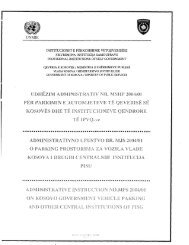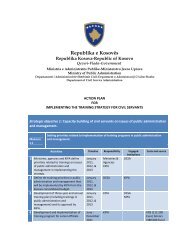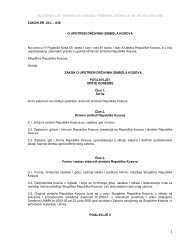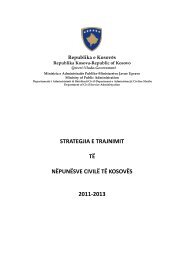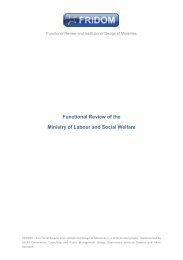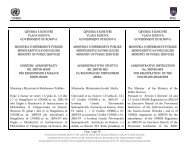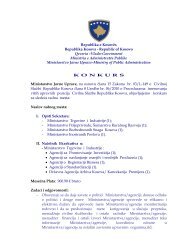Download
Download
Download
You also want an ePaper? Increase the reach of your titles
YUMPU automatically turns print PDFs into web optimized ePapers that Google loves.
organisational structures (departments, divisions, centres, agencies, offices, etc) and<br />
administrative instructions from Office of the Prime Minister that require certain structures.<br />
3. Undertake critical policy work that affects the structure and functions of the MOH. A<br />
policy direction with large potential to change the MOH is health insurance. The policy work<br />
could be rapidly strengthened so a realistic transition path is developed to move from where<br />
the health sector is now to a feasible model. An important building block is changing the<br />
MOH from an integrated policy maker and provider of services to a planning, policy, funding,<br />
monitoring and regulation role for the MOH with more autonomy for providers linked to<br />
robust accountability frameworks for those providers (hospitals and other agencies) as<br />
suggested in Appendix G. Other building blocks include: better health status analysis and<br />
demand analysis; improved health information on provider activity/services; specification of<br />
services; costing of services; defining the basic package that government can fund and<br />
aligning entitlements to this; complex contracting including designing contracts to manage<br />
the risks of cost shifting, cream skimming and other risks; monitoring many aspects of<br />
performance; improvements in configuration, efficiency and effectiveness of government<br />
owned providers; improvements in governance and accountability arrangements for<br />
government service providers; market development; and institutional development work for<br />
the health insurance model including investment risks (if this model proceeds). All these<br />
developments require leadership from the MOH, including policy analysis, planning and<br />
driving the implementation of many changes. The MOH could strengthen its capability in<br />
these areas and the restructuring of the ministry needs to address this. Further advice on<br />
this is set out in Appendix G.<br />
4. Use the opportunity to revise the Health Law to put policy changes into the legal<br />
framework including the improved governance and accountability arrangements for<br />
hospitals. The transition arrangements for the Ministry of Health to develop the<br />
purchasing/funding function could also be set out in the Health Law.<br />
Implementation of the Institutional Development Plan from 3 to 12 months- following<br />
completion of the work listed above for the first 3 months<br />
Ministry of Health internal changes (subject to the Institutional Development Plan):<br />
5. Reduce the number of reports to PS; consider creating a senior management level<br />
with more services represented on it in the form of directors of departments for: Public<br />
Health; Primary Health; Secondary and Tertiary Services; Pharmaceuticals; and Mental<br />
Health, as well as departments for Corporate Services (Administration and Finance); and<br />
Strategic Management. The best arrangement should be selected based on a thorough<br />
analysis.<br />
6. For each of the service departments listed above establish units for 1. policy and<br />
planning; 2. monitoring. Where these departments provide services, a third unit could be<br />
established for service provision. Variations on this are possible where there is a<br />
purchasing/funding function which could be undertaken by the Health Care Commissioning<br />
Agency or other options. An option covered in Appendix G is to locate the Health Care<br />
Commissioning Agency within a much strengthened Department of Strategic Management<br />
so the full resources of that department could be used to support the purchasing/funding<br />
function. All units should have staff members who are skilled in various areas and who are<br />
able to take on a range of work. The units should not have tightly segmented jobs focused<br />
on narrow areas of work.<br />
7. Reduce the number of corporate services type of reports by creating a Department of<br />
Corporate Services that includes finance and budget; administration and personnel; legal<br />
services; communications; and procurement.<br />
8. Strengthen the Department of Strategic Management so it has a unit for: 1. facilitating<br />
ministry-wide policy, ministry-wide planning, ministry-level reporting and ministry-level<br />
monitoring functions, as well as units for 2. HIMS; 3. Sector HR development and regulation;<br />
and 4. Productivity and quality improvement. There is an option to locate the Health Care<br />
Commissioning function in this department as a 5 th unit as discussed in Appendix G.<br />
6



